| [1] | N. M. Krylov and N. N. Bogoliubov, Introduction to nonlinear mechanics. Princeton, Princeton University Press, 1947 |
| [2] | N. N. Bogoliubov and Yu. A. Mitropolsky, Asymptotic methods in the theory of non-linear oscillations. New York, Gordon and Breach, 1961 |
| [3] | Th. J. Coakley, A Generalized Averaging Method for Linear Differential Equations with Almost Periodic Coefficients. National Aeronautics and Space Administration, Washington, D. C., 1969 |
| [4] | Ju. A. Mitropolsky, Method of an average in the nonlinear mechanics. Kiev, Naukova dumka, 1971 |
| [5] | J. A. Sanders and F. Verhulst, Averaging methods in nonlinear dynamical systems. Appl. Math. Sci., Springer-Verlag, New York, 1985, vol. 59 |
| [6] | V. M. Volosov and B. I. Morgunov, Metod of average in the theory of nonlinear oscillations. Мoscow, Moscow State University Publishing house, 1971 |
| [7] | P. Lochak, C. Meunier, Multiphase averaging for classical systems. Appl. Math. Sci., Springer-Verlag, New York, 1988, vol. 72 |
| [8] | N. A. Perestyuk, V. A. Plotnikov, A. M. Samoilenko and N. V. Skripnik, Differential equations with impulse effects: multivalued right-hand sides with discontinuities. De Gruyter Studies in Mathematics. Berlin/Boston: Walter De Gruyter GmbH&Co., 2011, vol. 40 |
| [9] | A. V. Plotnikov and N. V. Skripnik, Differential equations with ''clear'' and fuzzy multivalued right-hand sides. Asymptotics Methods. AstroPrint, Odessa, 2009 |
| [10] | V. A. Plotnikov, A. V. Plotnikov and A. N. Vityuk, Differential equations with a multivalued right-hand side: Asymptotic methods. AstroPrint, Odessa, 1999 |
| [11] | Zadeh, L. A., 1965, Fuzzy sets, Inf. Control, (8), 338-353, doi:10.1016/S0019-9958(65)90241-X |
| [12] | Kaleva, O., 1987, Fuzzy differential equations, Fuzzy Sets Syst., 24(3), 301-317, doi:10.1016/0165-0114(87)90029-7 |
| [13] | V. Lakshmikantham, T. Gnana Bhaskar and Devi J. Vasundhara, Theory of set differential equations in metric spaces. Cambridge, Cambridge Scientific Publishers, 2006 |
| [14] | V. Lakshmikantham and R. Mohapatra, Theory of fuzzy differential equations and inclusions. Taylor - Francis, 2003 |
| [15] | Park, J. Y., and Han, H. K., 1999, Existence and uniqueness theorem for a solution of fuzzy differential equations, Int. J. Math. Math. Sci., 22(2), 271-279, doi:10.1155/S016117129 9222715 |
| [16] | Park, J. Y., and Han, H. K., 2000, Fuzzy differential equations, Fuzzy Sets Syst., 110(1), 69-77, doi:10.1016/S0165- 0114(98)00150-X |
| [17] | Allahviranloo, T., Amirteimoori, A., Khezerloo, M., and Khezerloo, S., 2011, A new method for solving fuzzy volterra integro-differential equations, Australian Journal of Basic and Applied Sciences, 5(4), 154-164 |
| [18] | Balachandran, K., and Kanagarajan, K., 2005, Existence of solutions of fuzzy delay integrodifferential equations with nonlocal condition, Journal of Korea Society for Industrial and Applied Mathematics, 9(2), 65-74 |
| [19] | Balasubramaniam, P., and Muralisankar, S., 2001, Existence and uniqueness of fuzzy solution for the nonlinear fuzzy integrodifferential equations, Appl. Math. Lett., 14(4), 455-462, doi:10.1016/S0893-9659(00)00177-4 |
| [20] | Balasubramaniam, P., and Muralisankar, S., 2004, Existence and uniqueness of fuzzy solution for semilinear fuzzy integrodifferential equations with nonlocal conditions, Comput. Math. Appl., 47, 1115-1122, doi:10.1016/S0898-1221(04) 90091-0. |
| [21] | Aubin, J.-P., 1990, Fuzzy differential inclusions, Probl. Control Inf. Theory, 19(1), 55-67 |
| [22] | Baidosov, V. A., 1990, Differential inclusions with fuzzy right-hand side, Sov. Math., 40(3), 567-569 |
| [23] | Baidosov, V. A., 1990, Fuzzy differential inclusions, J. Appl. Math. Mech., 54(1), 8-13, doi:10.1016/0021-8928(90)90080 -T |
| [24] | Hullermeier, E., 1997, An approach to modeling and simulation of uncertain dynamical system, Int. J. Uncertain. Fuzziness Knowl.-Based Syst., 7, 117-137 |
| [25] | Plotnikov, A. V., and Skripnik, N. V., 2009, The generalized solutions of the fuzzy differential inclusions, Int. J. Pure Appl. Math., 56(2), 165-172 |
| [26] | Skripnik, N. V., 2009, The full averaging of fuzzy differential inclusions, Iranian Journal of Optimization, 1, 302-317 |
| [27] | Skripnik, N. V., 2011, The partial averaging of fuzzy differential inclusions, J. Adv. Res. Differ. Equ., 3(1), 52-66 |
| [28] | Kwun, Y. C., and Park, D. G., 1998, Optimal control problem for fuzzy differential equations, Proceedings of the Korea-Vietnam Joint Seminar, 103-114 |
| [29] | Phu, N. D., and Tung, T. T., 2007, Some results on sheaf-solutions of sheaf set control problems, Nonlinear Anal., 67(5), 1309-1315, doi:10.1016/j.na.2006.07.018 |
| [30] | Plotnikov, A. V., Komleva, T. A., and Arsiry, A. V., 2009, Necessary and sufficient optimality conditions for a control fuzzy linear problem, Int. J. Industrial Mathematics, 1(3), 197-207 |
| [31] | Kwun, Y. C., Kim, M. J., Lee, B. Y., and Park, J. H., 2008, Existence of solutions for the semilinear fuzzy integrodifferential equations using by successive iteration, Journal of Korean Institute of Intelligent Systems, 18, 543-548, doi:10.5391/JKIIS.2008.18.4.543 |
| [32] | Kwun, Y. C., Kim, J. S., Park, M. J., and Park, J. H., 2009, Nonlocal controllability for the semilinear fuzzy integrodifferential equations in n-dimensional fuzzy vector space, Adv. Difference Equ., vol. 2009, Article ID 734090, 16 pages, doi:10.1155/2009/734090 |
| [33] | Kwun, Y. C., Kim, J. S., Park, M. J., and Park, J. H., 2010, Controllability for the impulsive semilinear nonlocal fuzzy integrodifferential equations in n-dimensional fuzzy vector space, Adv. Difference Equ., vol. 2010, Article ID 983483, 22 pages, doi:10.1155/2010/983483 |
| [34] | Park, J. H., Park, J. S., and Kwun, Y. C., 2006, Controllability for the semilinear fuzzy integrodifferential equations with nonlocal conditions, Fuzzy Systems and Knowledge Discovery, Lecture Notes in Computer Science, vol. 4223/2006, 221-230, doi: 10.1007/11881599_25 |
| [35] | Park, J. H., Park, J. S., Ahn, Y. C., and Kwun, Y. C., 2007, Controllability for the impulsive semilinear fuzzy integrodifferential equations, Adv. Soft Comput., 40, 704-713, doi:10.1007/978-3-540-71441-5_76 |
| [36] | Molchanyuk, I. V., and Plotnikov, A. V., 2006, Linear control systems with a fuzzy parameter, Nonlinear Oscil., 9(1), 59-64, doi:10.1007/s11072-006-0025-2 |
| [37] | Molchanyuk, I. V., and Plotnikov, A. V., 2009, Necessary and sufficient conditions of optimality in the problems of control with fuzzy parameters, Ukr. Math. J., 61(3), 457-463, doi:10.1007/s11253-009-0214-0 |
| [38] | Plotnikov, A. V., and Komleva, T. A., 2009, Linear problems of optimal control of fuzzy maps, Intelligent Information Management, 1(3), 139-144, doi:10.4236/iim.2009.13020 |
| [39] | Plotnikov, A. V., Komleva, T. A., and Molchanyuk, I. V., 2010, Linear control problems of the fuzzy maps, J. Software Engineering & Applications, 3(3), 191-197 |
| [40] | Vasil'kovskaya, V. S., and Plotnikov, A. V., 2007, Integrodifferential systems with fuzzy noise, Ukr. Math. J., 59(10), 1482-1492, doi:10.1007/s11253-008-0005-z |
| [41] | Komleva, T. A., 2011, The full averaging of linear fuzzy differential equations with 2π-periodic right-hand side, J. Adv. Res. Dyn. Control Syst., 3(1), 12-25 |
| [42] | Plotnikov, A. V., 2011, The averaging of control linear fuzzy differential equations, J. Adv. Res. Appl. Math., 3(3), 1-20, doi: 10.5373/jaram.664.120610 |
| [43] | Plotnikov, A. V., and Komleva, T. A., 2010, The full averaging of linear fuzzy differential equations, J. Adv. Res. Differ. Equ., 2(3), 21-34 |
| [44] | Plotnikov, A. V., and Komleva, T. A., 2011, The averaging of control linear fuzzy 2π-periodic differential equations, Dyn. Contin. Discrete Impuls. Syst., Ser. B, Appl. Algorithms, 18(6), 833-847 |
| [45] | Plotnikov, A. V., Komleva, T. A., and Plotnikova, L. I., 2010, The partial averaging of differential inclusions with fuzzy right-hand side, J. Adv. Res. Dyn. Control Syst., 2(2), 26-34 |
| [46] | Plotnikov, A. V., Komleva, T. A., and Plotnikova, L. I., 2010, On the averaging of differential inclusions with fuzzy right-hand side when the average of the right-hand side is absent, Iranian Journal of Optimization, 2(3), 506-517 |
| [47] | Skripnik, N. V., 2011, The partial averaging of fuzzy differential inclusions, J. Advanced Research in Differential Equations, 3(1), 52–66 |
| [48] | Skripnik, N. V., 2011, The partial averaging of fuzzy impulsive differential inclusions, Differential and Integral Equations, 24(7-8), 743-758 |
| [49] | Puri, M. L., and Ralescu, D. A., 1986, Fuzzy random variables, J. Math. Anal. Appl., 114(2), 409-422, doi:10.1016/0022-247X(86)90093-4 |

 . Thereby we expand a circle of systems to which it is possible to apply Krylov-Bogolyubov method of averaging.
. Thereby we expand a circle of systems to which it is possible to apply Krylov-Bogolyubov method of averaging. be a set of all nonempty (convex) compact subsets from the space
be a set of all nonempty (convex) compact subsets from the space ,
, be Hausdorff distance between sets
be Hausdorff distance between sets  and
and ,
,  is
is  -neighborhood of set
-neighborhood of set .Let
.Let  be the set of all
be the set of all  such that u satisfies the following conditions:•
such that u satisfies the following conditions:•  is normal, that is, there exists an
is normal, that is, there exists an  such that
such that ;•
;•  is fuzzy convex, that is,
is fuzzy convex, that is,  • for any
• for any  and
and ;•
;•  is upper semicontinuous,•
is upper semicontinuous,•  is compact.If
is compact.If , then
, then  is called a fuzzy number, and
is called a fuzzy number, and  is said to be a fuzzy number space. For
is said to be a fuzzy number space. For , denote
, denote  .Then from 1)-4), it follows that the
.Then from 1)-4), it follows that the  -level set
-level set  for all
for all .Let
.Let  be the fuzzy mapping defined by
be the fuzzy mapping defined by  if
if  and
and .Define
.Define  by the relation
by the relation  where
where  is the Hausdorff metric defined in
is the Hausdorff metric defined in . Then
. Then  is a metric in
is a metric in .Further we know that[49]:1.
.Further we know that[49]:1.  is a complete metric space,2.
is a complete metric space,2.  for all
for all ,3.
,3.  for all
for all  and
and .Definition 1.[15] A mapping
.Definition 1.[15] A mapping  is measurable if for all
is measurable if for all  the set-valued map
the set-valued map defined by
defined by  isLebesgue measurable. Definition 2.[15] A mapping
isLebesgue measurable. Definition 2.[15] A mapping  is said to be integrably bounded if there is an integrable function
is said to be integrably bounded if there is an integrable function  such that
such that  for every
for every .Definition 3.[15] The integral of a fuzzy mapping
.Definition 3.[15] The integral of a fuzzy mapping  is defined levelwise by
is defined levelwise by 
 . The set
. The set  of all
of all  such that
such that  is a measurable selection for
is a measurable selection for for all
for all .Definition 4.[15] A measurable and integrably bounded mapping
.Definition 4.[15] A measurable and integrably bounded mapping  is said to be integrable over
is said to be integrable over  if
if .Note that if
.Note that if  is measurable and integrably bounded, then
is measurable and integrably bounded, then  is integrable. Further if
is integrable. Further if  is continuous, then it is integrable.Now we consider following fuzzy integrodifferential inclusion
is continuous, then it is integrable.Now we consider following fuzzy integrodifferential inclusion 
 means
means ;
;  is the state;is a fuzzy mapping,
is the state;is a fuzzy mapping,  is a fuzzy mapping,
is a fuzzy mapping,  ,
, . We interpret[21-24] the fuzzy differential inclusion (1) as a family of integrodifferential inclusions
. We interpret[21-24] the fuzzy differential inclusion (1) as a family of integrodifferential inclusions
 indicates that the
indicates that the  -level set of a fuzzy set is involved (the system (2) can only have any significance as a replacement for (1) if the solutions generate fuzzy sets (fuzzy R-solution)[24]).Let
-level set of a fuzzy set is involved (the system (2) can only have any significance as a replacement for (1) if the solutions generate fuzzy sets (fuzzy R-solution)[24]).Let  denotes the fuzzy R-solution of the fuzzy integrodifferential inclusion (1).
denotes the fuzzy R-solution of the fuzzy integrodifferential inclusion (1).
 is a small parameter. In this section we associate with the equation (3) the following averaged integrodifferential equation
is a small parameter. In this section we associate with the equation (3) the following averaged integrodifferential equation


 the following hold:1)
the following hold:1)  is continuous in
is continuous in ;2)
;2)  is continuous in
is continuous in ;3) there exist constants
;3) there exist constants  such that
such that  for all
for all , and any
, and any  ;4) there exist continuous functions
;4) there exist continuous functions ,
,  , and constant
, and constant  such that
such that  for any
for any , and any
, and any  5) there exist constants
5) there exist constants , and
, and  such that
such that 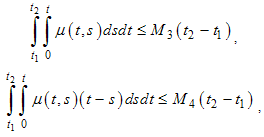 for any
for any ;6) there exist continuous functions
;6) there exist continuous functions  , and constants
, and constants  such that
such that 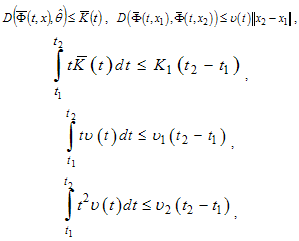 for any
for any  and
and  7) the limits (5),(6) exist uniformly in
7) the limits (5),(6) exist uniformly in ;8) for any
;8) for any  and
and  the fuzzy R-solution of the system (4) together with a
the fuzzy R-solution of the system (4) together with a  -neighbourhood belong to the domain
-neighbourhood belong to the domain .Then for any
.Then for any  and
and  there exists
there exists such that for all
such that for all  and
and the following statement fulfil:
the following statement fulfil:
 , are the fuzzy R-solutions of the initial and the full averaged equations.Proof. Let
, are the fuzzy R-solutions of the initial and the full averaged equations.Proof. Let  is any constant. In the beginning, usprove the validity of the inclusion for all
is any constant. In the beginning, usprove the validity of the inclusion for all 

 for all
for all . Let
. Let  is arbitrary and we prove the validity of the inclusion
is arbitrary and we prove the validity of the inclusion  for all
for all .We consider the integrodifferential inclusion
.We consider the integrodifferential inclusion 
 is any solution of the system (9). Then
is any solution of the system (9). Then 
 .Divide the interval
.Divide the interval  into partial intervals by the points
into partial intervals by the points We consider the function where
We consider the function where  .By conditions 3), and 4) of the theorem, we have
.By conditions 3), and 4) of the theorem, we have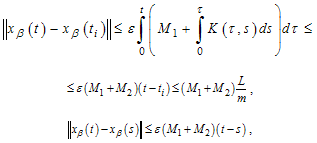 for all
for all  and
and .Also,
.Also, .Let
.Let . Then, we get
. Then, we get 
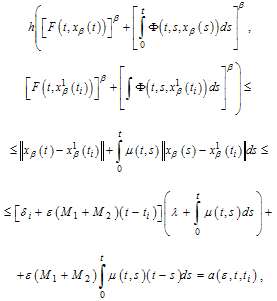 for all
for all .It follows, we have
.It follows, we have , for all
, for all .As
.As  for all
for all , then we get
, then we get  where
where  Therefore
Therefore for all
for all .Then we obtain
.Then we obtain Now we have function
Now we have function  such that
such that  where
where  .By condition 7) of the theorem, for any
.By condition 7) of the theorem, for any , there exists
, there exists  such that the following estimate is true for
such that the following estimate is true for :
: Hence,
Hence,  Then
Then Also we have
Also we have for all
for all .From here and by conditions 3), 6) of the theorem, we obtain
.From here and by conditions 3), 6) of the theorem, we obtain where
where  Therefore,
Therefore,

 of inclusion
of inclusion  that for all
that for all 
 where
where  Than we obtain
Than we obtain Also
Also  , then there exist
, then there exist  such that
such that ,for all
,for all . Hence
. Hence , for all
, for all  is arbitrary, then
is arbitrary, then , for all
, for all .Now, we proof, that
.Now, we proof, that , for all
, for all . Also, let
. Also, let  is arbitrary and we prove the validity of the inclusion
is arbitrary and we prove the validity of the inclusion  for all
for all .We consider the integrodifferential inclusion
.We consider the integrodifferential inclusion 
 is any solution of the system (14). Then
is any solution of the system (14). Then 
 Divide the interval into partial intervals by the points
Divide the interval into partial intervals by the points  . We consider the function
. We consider the function  where
where  By conditions 6), and 8) of the theorem, we have
By conditions 6), and 8) of the theorem, we have for all
for all  .Let
.Let . Then (similarly (12)), we get
. Then (similarly (12)), we get  and
and As
As  for all
for all , then we get
, then we get  where
where  Therefore for all
Therefore for all 
 where
where  Then, we obtain
Then, we obtain Now we have function
Now we have function  such that
such that  where
where  By condition 7) of the theorem, for any
By condition 7) of the theorem, for any , there exists
, there exists  such that the following estimate is truefor
such that the following estimate is truefor :
: Hence,
Hence,  Then
Then Also we have
Also we have for all
for all .From here and by conditions 3), and 6) of the theorem, we obtain
.From here and by conditions 3), and 6) of the theorem, we obtain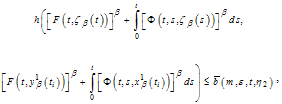 where
where 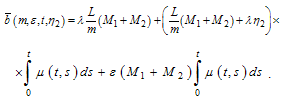 Therefore,
Therefore,
 of inclusion
of inclusion that for all
that for all 
 Where
Where Than we obtain
Than we obtain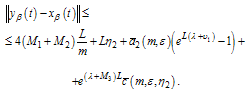 Also
Also  thenthere exist
thenthere exist  such that
such that  ,for all
,for all  . Hence
. Hence  , for all
, for all  . As
. As  is arbitrary, then
is arbitrary, then  , for all
, for all  . This concludes he proof.
. This concludes he proof. Abstract
Abstract Reference
Reference Full-Text PDF
Full-Text PDF Full-Text HTML
Full-Text HTML